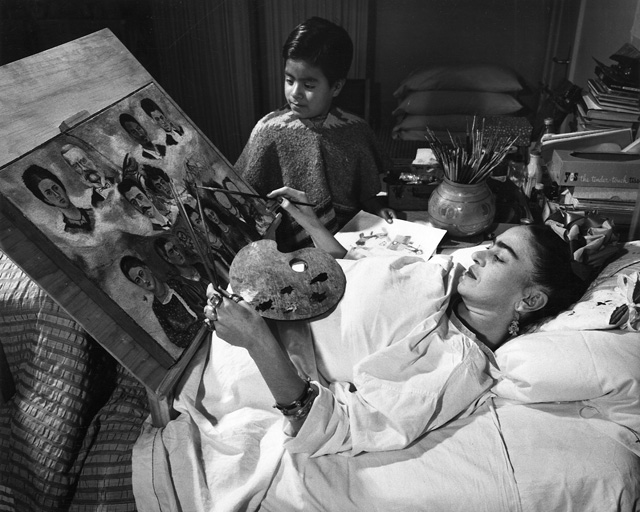| |  | Frida Kahlo |  |
| "I paint myself because I am so often alone and because I am the subject I know best." *** Frida Kahlo (1907-1954) was born in Mexico City, in her home known as the Blue House. Kahlo, who had Indian blood on her mother’s side, was of Hungarian-Jewish descent on her father’s. Her work has been celebrated in Mexico as emblematic of national and indigenous tradition, and by feminists for its uncompromising depiction of the female experience and form. Mexican culture and Amerindian cultural tradition are important in her work, which has been sometimes characterized as Naïve art or folk art. Her work has also been described as "surrealist". |  |
Kahlo's life began and ended in Mexico City, in her home known as the Blue House. She gave her birth date as July 7, 1910, but her birth certificate shows July 6, 1907. Kahlo had allegedly wanted the year of her birth to coincide with the year of the beginning of the Mexican revolution so that her life would begin with the birth of modern Mexico. At age 6 years, Frida developed polio, which caused her right leg to appear much thinner than the other. It was to remain that way permanently. She began to paint in 1925 while recovering from a streetcar accident that left her permanently disabled. She underwent more than thirty operations in the course of her life, and many of her approximately two hundred paintings directly relate to her experiences with physical pain. They also chronicle her turbulent relationship with Diego Rivera. Frida let out all of her emotions on a canvas. Kahlo met Rivera in 1928 and married him in 1929. She shared his faith in communism and passionate interest in the indigenous cultures of Mexico. Rivera encouraged Kahlo in her work, extolling her as authentic, unspoiled and primitive, and stressing the Indian aspects of her heritage. During her lifetime, Kahlo did not enjoy the same level of recognition as the great artists of Mexican muralism, Rivera, Orozco, and Siqueiros. However, over the last two decades that has changed and today Kahlo’s idiosyncratic, intensely autobiographical work is critically and monetarily as prized as that of her male peers, sometimes more so. Frida Kahlo attempted suicide a couple of times. On July 13, 1954, she died. No official autopsy was done and suicide is rumored. |
|
| |
|  | | "Self-portrait with the Portrait of Doctor Farill" (1951) Oil on masonite, 42 x 50 cm - 16 ½ x 19 ¾ in. Private collection, Mexico City, Mexico. | |  | 
|  |  | "Self-portrait with Necklace of Thorns" (1940) Oil on canvas, 63.5 x 49.5 cm - 25 x 19 ½ in. Harry Ransom Humanities Research Center Art Collection, University of Texas, Austin, Texas, USA. | | | 
|  |  | "Self-portrait" (1948) Oil on masonite, 50 x 39.5 cm - 19 ¾ x 15 ½ in. Collection of Dr. Samuel Fastlicht, Mexico City. | |  | 
|  |  | "Self-portrait with Monkeys" (1943) Oil on canvas, 81.5 x 63 cm - 32 x 24 ¾ in. Collection of Jacques & Natasha Gelman, Mexico City, Mexico. | | | 
|  |  | "Portrait of Diego Rivera" (1937) Oil on wood, 45.7 x 31.8 cm - 18 x 12 ½ in. Collection of Jacques & Natasha Gelman, Mexico City, Mexico. | | | 
|  |  | "The Love Embrace of the Universe, the Earth (Mexico), Myself, Diego and Señor Xólotl" (1949) Oil on canvas, 70 x 60.5 cm - 27 ½ x 23 ¾ in. Collection of Jacques & Natasha Gelman, Mexico City, Mexico. |
| Text source: various. |
|  | "I am not sick. I am broken. But I am happy as long as I can paint." | |
 | share this page (aged 13 or over only) |
| | |
|
|
|